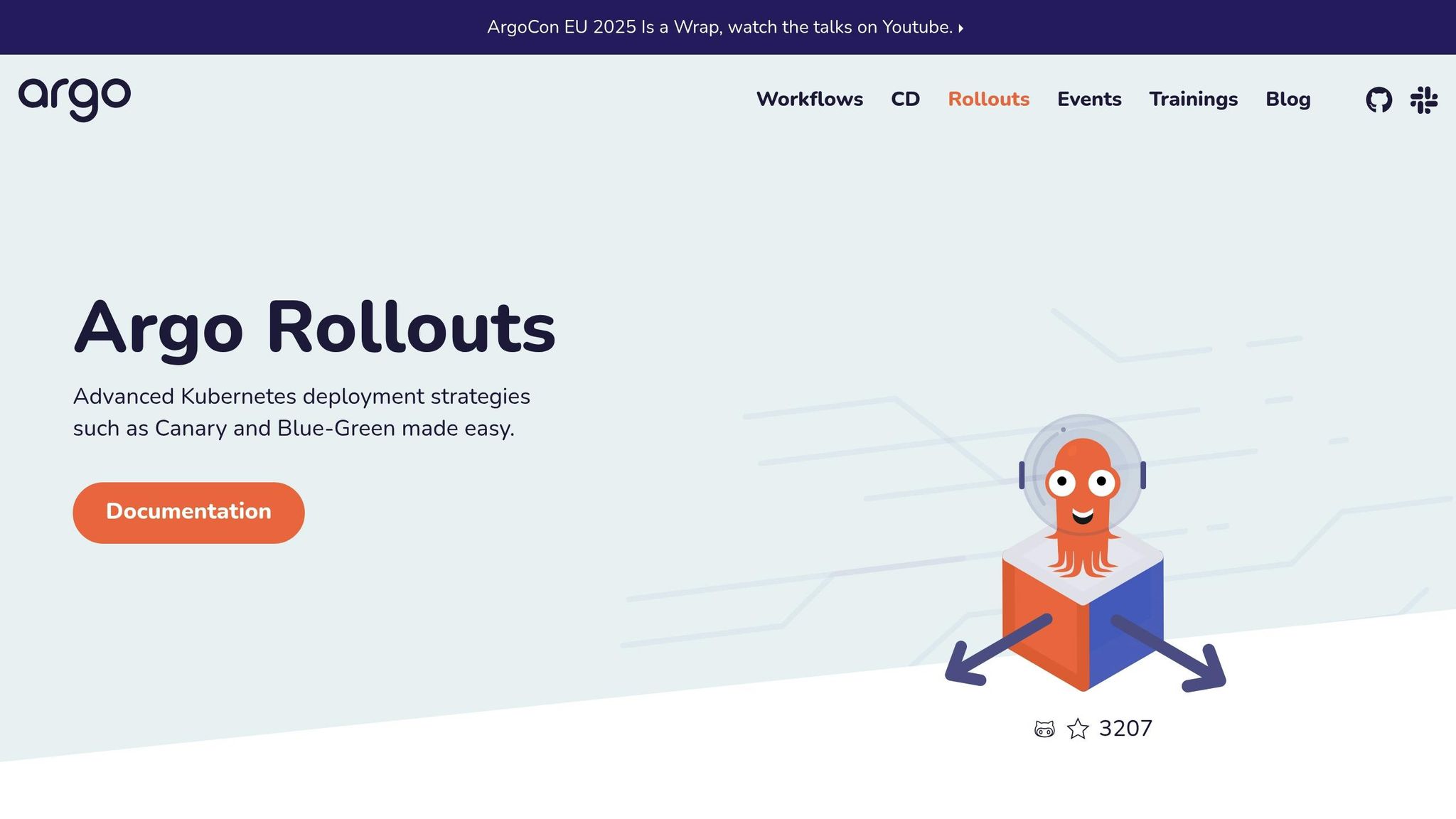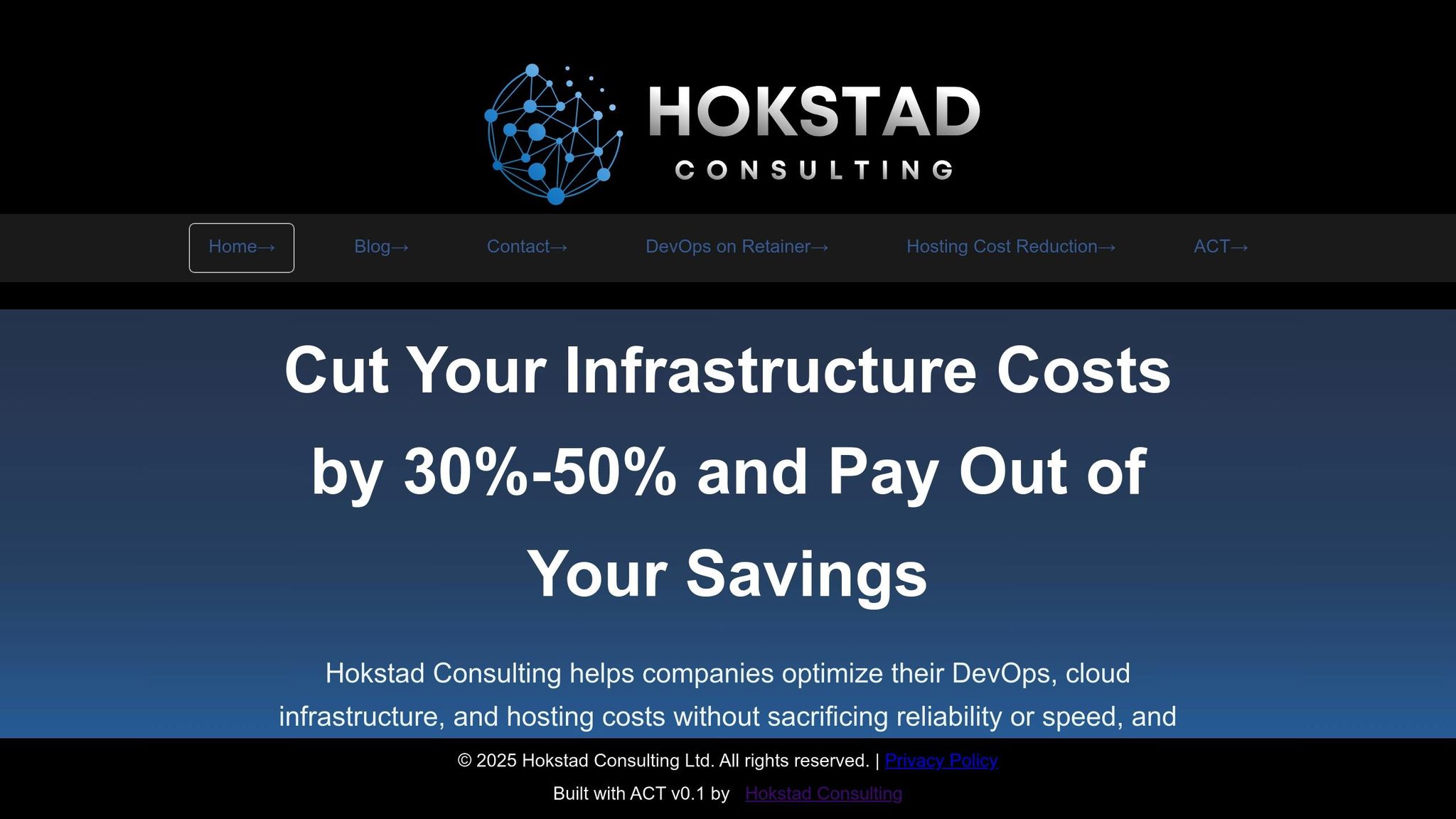Progressive delivery allows teams to roll out software updates gradually, reducing risks and improving reliability. By using traffic shaping, organisations can control which users see new features and when, ensuring stability and faster feedback. Key techniques include canary deployments, blue-green deployments, percentage rollouts, and ring deployments. These methods help detect issues early, limit their impact, and offer quick rollback options.
Key Points:
- What it is: Controlled, incremental rollouts of software updates using tools like feature flags and automated rollback mechanisms.
- Traffic shaping: Directs user traffic to different application versions based on rules like location or user type.
- Benefits: Reduces deployment risks, enables faster feedback, and ensures smoother user experiences.
- Techniques: Canary, blue-green, percentage rollouts, and ring deployments, each suited for different scenarios.
- Tools: Kubernetes, Istio, Argo Rollouts, Spinnaker, and GitLab CI/CD streamline traffic shaping within CI/CD pipelines.
Why it matters: Progressive delivery ensures updates are tested safely with minimal downtime, helping organisations deploy faster while maintaining system stability.
Progressive Delivery Made Easy With Argo Rollouts - Kevin Dubois, Red Hat

Traffic Shaping Methods for Progressive Delivery
Progressive delivery relies on several traffic shaping techniques, each offering unique levels of control, complexity, and risk management. By understanding these approaches, organisations can select the most effective strategy for their deployment needs and infrastructure capabilities. Let's break down these methods to explore their strengths, costs, rollback speed, and complexity.
Common Traffic Shaping Techniques
Canary deployments are one of the safest ways to manage traffic during a rollout. In this method, only a small percentage of users - typically between 1% and 5% - are directed to the new version, while the majority continue using the stable release.
This approach is particularly useful for high-traffic applications, where even a small percentage of users provides enough data for meaningful testing. During a canary deployment, teams closely monitor metrics such as error rates, response times, and user interactions to detect potential issues early.
Blue-green deployments take a different route by maintaining two fully operational production environments. The blue
environment runs the current version, while the green
environment hosts the new release. Once the green environment is confirmed stable through testing, all traffic is switched over from blue to green. This method allows for instant rollback if needed, but it comes with the added cost of maintaining duplicate infrastructure.
Percentage rollouts give teams precise control over traffic distribution. Unlike canary deployments that follow fixed stages, percentage rollouts allow any specific traffic split, such as directing 15% of users to the new version while leaving 85% on the current one. This method often incorporates user segmentation, such as targeting premium customers or specific regions, to gather focused feedback while limiting risk.
Ring deployments use a phased rollout strategy, starting with internal teams and gradually expanding to broader user groups. The innermost ring
typically includes developers and quality assurance teams. Subsequent rings might include beta users or friendly customers, with each stage validating the release before moving to the next group. This method works especially well for consumer applications, where feedback quality can vary significantly between user groups.
These techniques form the backbone of progressive delivery, enabling organisations to achieve seamless rollouts with minimal downtime and efficient resource use.
Traffic Shaping Strategy Comparison
| Method | Risk Level | Infrastructure Cost | Rollback Speed | Complexity | Best Use Case |
|---|---|---|---|---|---|
| Canary Deployment | Low | Medium | Fast | Medium | High-traffic applications needing gradual testing |
| Blue-Green Deployment | Medium | High | Instant | Low | Applications requiring quick, full rollouts |
| Percentage Rollout | Low | Medium | Fast | High | Features needing precise traffic allocation |
| Ring Deployment | Very Low | Low | Medium | High | Applications with diverse user groups |
Risk levels differ greatly across methods. Canary and percentage rollouts limit exposure by testing with smaller user groups. Blue-green deployments carry a higher risk since issues affect all users at once, but problems are quickly reversible. Ring deployments, with their step-by-step validation, offer the lowest risk.
Infrastructure costs also vary. Blue-green deployments are the most resource-intensive due to their need for duplicate environments. Ring deployments are more cost-efficient, while canary and percentage rollouts fall somewhere in the middle.
Rollback speed is a critical factor in addressing issues. Blue-green deployments allow instant rollback by simply switching traffic. Canary and percentage rollouts are also quick to reverse, as traffic can be redirected to the stable version. Ring deployments, however, may take longer since traffic adjustments occur across multiple user groups.
Complexity can influence the effort needed for implementation and maintenance. Blue-green deployments are relatively straightforward but require careful synchronisation between environments. Percentage rollouts and ring deployments demand more advanced routing and monitoring systems. Canary deployments strike a balance, offering functionality without excessive implementation challenges.
This comparison highlights the strengths and trade-offs of each method, helping teams decide how to integrate them into their CI/CD workflows. Many organisations adopt hybrid strategies - using ring deployments for major releases and percentage rollouts for smaller updates - to balance the advantages of each technique while addressing their limitations.
Adding Traffic Shaping to CI/CD Pipelines
Bringing traffic shaping into CI/CD pipelines automates progressive delivery, balancing speed with reduced risk. This approach supports zero-downtime deployments and helps optimise cloud performance.
CI/CD Tools for Traffic Shaping
Kubernetes plays a central role in many traffic shaping setups, thanks to its service mesh capabilities and ingress controllers like NGINX and Istio. These tools allow precise traffic splitting based on factors such as HTTP headers, user groups, or geographic location.
Argo Rollouts simplifies canary and blue-green deployments by working with service meshes and ingress controllers. It can pause deployments for metric-based validation and uses analysis templates to define success benchmarks.
Spinnaker provides enterprise-level orchestration with multi-cloud traffic shaping built in. Its pipeline stages handle complex workflows, including automated traffic splitting, monitoring for validation, and rollback processes, all while maintaining consistent traffic management across environments.
GitLab CI/CD integrates progressive delivery through its Auto DevOps feature. This automatically sets up canary deployments for Kubernetes-based applications, streamlining the process by combining source code management, CI/CD pipelines, and deployment orchestration in one interface.
Jenkins remains a favourite for traffic shaping due to its vast plugin ecosystem. With tools like the Kubernetes Continuous Deploy plugin and the Blue Ocean interface, teams can build custom deployment pipelines that include traffic management. Its flexibility supports integration with a variety of traffic shaping tools and service meshes.
Modern service meshes, such as Istio and Linkerd, offer advanced traffic management infrastructure. By injecting sidecar proxies alongside application containers, they provide detailed control over routing, load balancing, and observability - all without modifying the application code.
While these tools are essential, successful implementation also depends on meeting specific integration requirements.
Requirements for Traffic Shaping Integration
Effective traffic shaping relies on more than just tools - it requires well-defined operational practices.
Real-Time Observability
Teams must monitor application metrics, infrastructure performance, and business outcomes in real time. Distributed tracing can help track requests across microservices, while custom metrics and alerting systems ensure rapid responses to deployment issues. Establishing baseline metrics, such as error rates, response times, throughput, and user satisfaction, is critical for meaningful comparisons during new deployments.
Feature Flag Management
Tools like LaunchDarkly or Split allow runtime configuration changes without needing new deployments. This flexibility is especially useful for disabling features or adjusting configurations immediately if traffic shaping uncovers issues.
Automated Rollbacks
Set up rollback mechanisms that monitor key performance indicators and redirect traffic to a stable version if problems occur. Clearly defined success criteria ensure only deployments meeting quality standards progress further.
Configuration Management
Managing multiple environments with different traffic shaping policies requires consistent practices. Infrastructure-as-code approaches help deploy and configure rules across development, staging, and production environments, while version control ensures consistency in traffic splitting, monitoring thresholds, and rollback processes.
Security Measures
Traffic shaping must not compromise security. Teams should authenticate and authorise deployment tools, encrypt service-to-service traffic, and audit deployment activities to prevent exposing sensitive data or introducing vulnerabilities.
Team Coordination
Automated traffic shaping demands updated team workflows. This includes setting deployment schedules to avoid conflicts, establishing communication protocols to share deployment statuses, and defining escalation procedures for manual intervention when necessary.
Need help optimizing your cloud costs?
Get expert advice on how to reduce your cloud expenses without sacrificing performance.
Cost and Performance Benefits of Progressive Delivery
Progressive delivery, combined with traffic shaping, offers a practical way to cut costs and improve operational efficiency. By minimising deployment risks and optimising resource use, this method reshapes how organisations handle cloud expenses while ensuring top-notch service availability.
Cutting Cloud Costs with Progressive Delivery
Progressive delivery helps organisations save money by addressing issues early in the deployment process. Fixing problems sooner rather than later not only saves time but also avoids unnecessary expenses.
Since it's generally much cheaper to make changes early on in the development cycle, this strategy can save a lot of money over time.– CloudBees [1]
Limiting the blast radius
of potential issues is another way it keeps costs in check. For instance, if resource usage spikes during the initial rollout, deployments can be paused to prevent further impact. This keeps cloud expenses under control and avoids waste.
Early detection of bugs also plays a big role in cost savings. As Dan Lorenc, Founder/CEO at Chainguard, points out:
Just like the book Mythical Man Month said 40 years ago, the cost of fixing a software defect increases dramatically the later it is found.[2]
By monitoring resource usage during phased rollouts, inefficiencies can be spotted and corrected before they turn into bigger, more expensive problems. Plus, with automation baked into progressive delivery, manual tasks are reduced, lowering operational costs and improving efficiency.
Zero Downtime Deployment in Action
The cost advantages of progressive delivery go hand in hand with its performance benefits. Traffic shaping ensures near-zero downtime during deployments, keeping services up and running even as changes are rolled out. By gradually shifting user traffic from an old version to a new one, any performance hiccups can be quickly identified and addressed. If needed, the system can revert to the earlier version with minimal disruption to users.
This method not only enhances reliability but also ensures a smooth experience for end users, even during major updates.
How Hokstad Consulting Supports Progressive Delivery

Hokstad Consulting leverages these benefits to offer tailored progressive delivery solutions that improve both cost management and performance. Their services combine DevOps transformation with cost efficiency strategies to deliver measurable results for clients.
Under their DevOps Pipeline Optimisation services, Hokstad Consulting creates automated CI/CD pipelines designed for gradual rollouts. These pipelines include traffic shaping, automated monitoring of performance metrics, and quick rollback capabilities. This reduces manual effort and ensures dependable releases.
Their Cloud Cost Engineering services focus on identifying and fixing inefficiencies in resource usage and deployment processes. By implementing detailed monitoring during rollouts, they help organisations reduce cloud costs by as much as 30–50%. This proactive approach prevents overspending caused by inefficient deployments.
Through Strategic Implementation, Hokstad Consulting develops customised progressive delivery plans tailored to a business's unique infrastructure. They identify the best integration points for traffic shaping tools and create roadmaps that minimise disruption while maximising benefits across public, private, and hybrid cloud setups.
To ensure long-term success, Hokstad Consulting offers ongoing support through a retainer model. As applications grow and traffic patterns shift, they adjust traffic shaping strategies to maintain peak performance and cost efficiency.
With their technical know-how and focus on reducing costs, Hokstad Consulting is well-equipped to help organisations take full advantage of progressive delivery and traffic shaping.
Research Findings and Implementation Examples
Expanding on earlier discussions about the cost and performance benefits, this research confirms the technical strengths of traffic shaping. When integrated into progressive delivery, traffic shaping significantly boosts deployment reliability and overall system performance.
Traffic Shaping Research Results
In May 2023, Nagateja Alugunuri conducted a study titled Progressive Delivery in CI/CD Pipelines: Evaluating Canary, Blue-Green, and Feature Flag Strategies.
This research introduced a unified CI/CD pipeline that combined Canary, Blue-Green, and Feature Flag strategies. The setup utilised Istio for traffic management, Launch Darkly for feature toggling, Kubernetes for orchestration, and Prometheus/Grafana for monitoring. Testing outcomes were impressive: a 40% reduction in Mean Time to Recovery (MTTR), system availability exceeding 99.98%, and improved rollback precision[3]. These results highlight the potential for further exploration into implementation challenges and evolving best practices.
Implementation Challenges and Best Practices
While the study emphasised performance improvements, future research aims to incorporate AI-driven monitoring tools and expand the unified model to support multi-cloud and edge computing environments[3].
Conclusion
Progressive delivery combined with traffic shaping is reshaping how software deployment and infrastructure management are approached. Together, these methods enhance system reliability and help reduce operational costs.
Key Takeaways
Evidence shows that traffic shaping can turn progressive delivery from a theoretical concept into a practical tool for businesses. By combining various traffic shaping techniques, organisations can make deployments more resilient while improving recovery times, system availability, and overall system performance.
With traffic shaping, businesses can safely test new features, roll out updates without service interruptions, and ensure users enjoy a seamless experience - even during significant system changes. Gradual traffic shifts also make it easier to detect and address issues early on.
When integrated into CI/CD pipelines, these practices simplify software delivery by cutting down on manual tasks and reducing the risk of human error. Tools like Istio for managing traffic, Kubernetes for orchestration, and monitoring solutions such as Prometheus and Grafana provide a solid technical foundation for implementing reliable progressive delivery strategies.
Moving Forward with Progressive Delivery
The next step is to embrace progressive delivery and traffic shaping. By leveraging expertise in DevOps and cloud infrastructure, businesses can unlock the full potential of these practices.
Hokstad Consulting offers specialised support in DevOps transformation and cloud optimisation. Their expertise spans automated CI/CD pipelines, seamless cloud migrations with zero downtime, and cost-saving strategies that can cut cloud expenses by 30–50%. They empower organisations to achieve both the operational and financial benefits of progressive delivery.
Looking ahead, traffic management and automated delivery processes are set to define the future of software deployment. Companies adopting these practices will gain a competitive edge with faster feature rollouts, more reliable systems, and lower operational costs. Progressive delivery with traffic shaping is becoming a core strategy for achieving measurable business success.
FAQs
How does traffic shaping improve progressive delivery in software deployments?
Traffic shaping plays a key role in progressive delivery by giving teams the ability to carefully manage how user traffic is routed during software updates. This method lets you gradually transition traffic from an older version to a new one, helping to minimise disruptions and lower the risks tied to sudden changes.
What makes traffic shaping even more effective is the ability to monitor key metrics, like performance and stability, in real time. This data helps teams make smarter decisions - whether to move forward, hit pause, or even roll back a deployment. By ensuring only stable and well-performing updates are rolled out, traffic shaping enhances deployment safety and creates a smoother experience for users, especially in fast-paced environments like Kubernetes.
What factors should organisations consider when selecting the right traffic shaping technique for their deployment needs?
When choosing a traffic shaping approach, organisations should focus on how well it meets their deployment pipeline’s needs for speed, reliability, and security. The method should improve deployment efficiency, avoiding unnecessary delays or bottlenecks, while ensuring resources are used effectively and performance remains consistent - even during peak demand or critical updates.
It’s also important to select a technique that supports automation and monitoring. This allows for quicker feedback and simplifies troubleshooting, helping maintain a stable and efficient pipeline that can adapt to changing operational requirements without compromising on quality.
How can organisations maintain secure and reliable systems while using traffic shaping in their CI/CD pipelines?
When implementing traffic shaping in CI/CD pipelines, maintaining security and reliability is essential. Organisations should embrace a layered security approach, which involves proactive risk management, consistent vulnerability assessments, and embedding security checks within the pipeline itself.
By automating testing and monitoring at every stage of development and deployment, potential risks can be spotted and addressed early on. This not only helps preserve system integrity but also minimises the chances of disruptions. Regular assessments and automated protections play a key role in ensuring systems remain reliable and safeguarded against vulnerabilities during traffic shaping activities.
